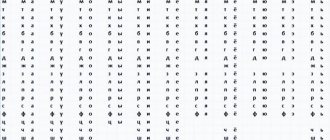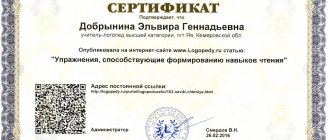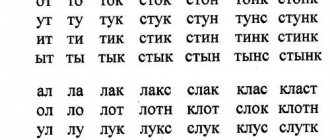Training sounds of Russian speech, letter mosaic. Vocabulary of 1000 words. Simple (3 syllables) and complex words (5 syllables). Teach children to read warehouses online.
| Spell Reading | Reading by warehouses |
| Ma - mu | |
| Ma - g - ra - e - h |
I think you will agree that even with machine voice acting, words spoken syllable by syllable sound much more humane - it is on this simple principle that the tasks of this site are built. Each letter and word has a hint - if the child cannot read the word, he can click on the word and hear the sound.
Why children can't learn to read
Have you ever wondered why your child cannot read, although he knows all the letters? We also thought about it, and therefore decided to create this project, which allows us to engage in early development methods, for example, teaching reading even before the child learned to speak. We decided to make a website for teaching children to read because for a long time we could not understand why my daughter could not learn to read. The daughter added the letters Me + A + Me + A
and I couldn’t get the word
MOM
.
How much we got on each other's nerves! But it turns out that you need to read not by letters, but by combinations of letters. MA + MA
(by warehouses). This site talks about how to easily and simply teach a child to read and have fun at the same time. The games presented on this site were developed by my husband - play for fun and tell your friends about the site, most likely their children are experiencing the same difficulties. as is yours. Video channel on early childhood education on YouTube.
From the correspondence:
Good day!! Thank you for your reading training site!!! This is a brilliant invention. My son made progress in mastering syllables in a couple of evenings. Learns, reads, remembers. And he likes it!!! We visited two children's training centers with very little results, but in two evenings of your classes we made a breakthrough!! I'm wondering how long should a lesson last? And doesn’t it matter that we go randomly on assignments, choosing what interests him?
Thanks a lot. Sincerely, mother ****.
Syllable emphasis
Below we describe general approaches to highlighting syllables in words for the traditional school and with in-depth study. For detailed materials with explanations and examples, see the rules page for dividing words into syllables.
Traditional school
The main rule of the regular school curriculum, which the child is guided by: as many vowels, as many syllables. When translating words, they are guided by the rules: we transfer the word by syllables, you cannot leave one letter on a line. Everyone knows these rules.
When dividing a word into syllables, you can use the push method: we place our palm to our mouth and feel the push of air as we pronounce the word. Or we imagine a candle in front of us: the number of times the flame flickers, the number of syllables. For some words with flowing consonants, this option is not always suitable.
The principles of teaching division into syllables vary in different primary schools. In some schools, they are taught to visually divide a word into parts - vowel + consonant connectives (or vowel + several consonants). Other schools teach how to pronounce a word with pauses in a convenient way. Pauses create places for dividing syllables.
School of Advanced Study
In schools for in-depth study of the Russian language and in institute programs, cases are dealt with when words are not transferred into syllables, that is, the syllable of transfer does not coincide with the phonetic syllable.
The division of a word into syllables occurs in such a way that the syllable is pronounced in increasing order: from voiceless pronunciation to voiced pronunciation. Therefore, syllables consisting of several sounds always begin with a voiceless consonant and end with a vowel. For example: by mail (but not by mail), mo-shka (but not by mosh-ka). A syllable can end with a voiced consonant (sonorant r, l, m, n), which sounds less sonorous than a vowel, but louder than a voiceless consonant. For example: bun, cook.
Android application for teaching reading. Syllables - Words - Phrases
Open in new window
Sections of the site:
Articles on teaching preschoolers to read | Children's forum archive | Feedback from authors | ABC for children | Alphabet games for kids | Primer for learning to read | Setting the sounds of the Russian alphabet (home speech therapist) | Reading by Warehouse | Letters | | Books | Articles | Speech therapy | Teaching preschoolers to read
Open and closed syllables
Syllables can be open or closed. In Russian words, most syllables are open. Open syllables organize
- perch
- a-ir
- swamp
- fiber
Closed syllables form
- nail
- cover
- pigeon
- locomotive
- hundred-rozh
Unpaired voiced consonants [й'], [л], [л'], [м], [м'], [н], [н'], [р], [р'] can form a closed syllable in any phonetic positions: at the beginning, in the middle and at the end of words:
- mirror
- Bol-tick
- sa-ray-chik
- sa-ra-fan
Oral exercises to strengthen the skill of dividing words into syllables
The following exercises will help you clearly demonstrate the topic:
- Experiment with a candle. Light a candle. Sit opposite. Say loudly, actively exhaling air, different words. For every syllable the flame will oscillate. Count together the number of hesitations for each word. It will also be interesting for the child to come up with words himself and count the number of syllables in them. Experiment: name short one-syllable words, and then come up with long ones that will make the flame fluctuate many times.
- Hand clapping. Invite the boy or girl to clap their hands for each syllable in the word. Let the words compete to see which one will receive more applause.
- Let's try it by touch. Place your horizontally straightened hand under your chin. Let your little scientist do the same. Pronounce monosyllabic and polysyllabic words. For each syllable, the chin and mouth will move and the mouth will open.
- Pedometer. Imagine that every step you take is one syllable. Say the words and step on each syllable. Ask your child how many steps it takes to say different words. First, do the exercises with your child. And then let him learn to use pitch to measure the number of syllables on his own.
- Young musician (builder, telegraph operator). Try to designate each syllable with some sound (beat on a drum, knock of a hammer) that your child likes. How will the words sound?
To master the material, give your child the opportunity to measure the syllables in steps, feel them with his hands and create his own unique melodies for each word.
How to correctly divide words into syllables?
Words are divided into phonetic syllables according to the number of vowel sounds. A word contains as many syllables as there are vowels. One vowel sound surrounded by consonants creates a monosyllabic word that is not divided into syllables:
- som
- mole
- waltz
- ford
To be able to divide a word into syllables, it must have at least two vowel sounds that form two-syllable words:
- hedgehog
- do-mik
- salad
- rabbit
If a sonorant consonant is between two vowels, then
- crow
- pendant
- covet
- cla-nya-tsya (-tsya sounds like [tsa])
When dividing into syllables, we take into account that the syllable ends with a vowel, and the group of subsequent noisy consonants, in combination with or without a sonorant sound, moves off at the boundary of the syllable division to the next phonetic syllable:
- no-chnik
- roof
- cork
- Creation
Only unpaired voiced consonants in the middle of a word can close a syllable:
- alphabet
- construction
- quarter
- lan-dy-she-vy
- silent
If a word has the same consonants, then they begin the next phonetic syllable:
- program
- te-nnny-sny
- sneakers
- parallel
This division into syllables is phonetic, which does not coincide with the orthographic hyphenation of words with double consonants.
The letters “й”, “ь”, “ъ” belong to the syllable after which they are written:
- rail
- flakes
- departure
- lifting
Let us indicate the order in which words are divided into syllables using the following algorithm.
How to divide a word into syllables with a combination of consonants
How to divide a word into syllables if there are several consonants nearby in the middle? How to correctly break a word into syllables: cat or cat? You need to understand the principle of so-called greater sonority. It is observed in the second case. From consonant to vowel. First there is a dull sound, then a voiced consonant, and at the end a vowel - shka. The first syllable ends with a vowel (ko). Such syllables are called open. We have much more of them than those that end with consonants: table, chair (they are called closed syllables).
In the middle of a word, the syllable is usually open, that is, it ends with a vowel sound: stra-na. According to the principle of increasing sonority, all consonants move in most cases to the subsequent syllable: cat.
If several consonants are combined in the middle of a word, then all the consonants following the vowel go to the next syllable: o-flow. These can be the same consonants or simply combinations of different consonants: o-flow, sha-pka, ko-shka.
An exception to this point: only those syllables in the middle of a word that end with unpaired consonant voiced sounds (they are called very voiced, sonorant) end with a consonant: [й], [р], [р'], [л], [л '], [m], [m'], [n], [n']: may-ka, San-ka, man-ka.
If in a word several sounds merge into one sound, then they all go to one syllable: zhu-zhzh (Zh)at, distracted (CA). In these cases, one should not confuse division into syllables and morphemic division for transferring a word: for example, we divide o-teket by syllables, but for transfer we divide the same word like this - ot-tek.
To summarize the rule more clearly:
Words are “cut” into syllables after each vowel. How many vowels, so many syllables.
BUT: if after a vowel there are r, rь, l, l, m, m, n, n, y , and there is also a paired consonant behind them, they (sonorant and sonorant with ь) go to the previous syllable.
If these consonants are 2 identical (nn, mm, ll..., 2 any sonorant, paired, first paired then unpaired), they go to the next syllable.
To avoid confusion, refresh your mind about the transfer rules >>
Games to familiarize children with syllables
Play these simple games with your child:
- "Friends". Use cut-out paper letter cards or a magnetic alphabet for this game. Tell them that the letters are looking for their friends, and when they find them, they hug. Show how the letters “H” and “A” run towards each other, how they hug. Say the syllable “NA” while doing this. Show other examples. Help your child make pairs of letters (syllables) himself.
- "Find friends." When you walk with your child, pay attention to posters, advertisements, and signs. Look for letters that are friends. Let the baby learn to find as many syllables as possible.
- "Rearrangement." Learn to swap syllables in words so that you get new words. Immediately when teaching this game, use visual materials: syllables written on paper or laid out from a magnetic alphabet. Over time, you can teach your child to do the task by ear. Examples of words: sos-na, ban-ka, weight-na, ni-tka, shi-na, lo-zha, tea-ka, ra-no, sy-ro, skala, hole-ra, ski-zhi .
Cards with letters, magnetic alphabet and other teaching aids will be useful for teaching division into syllables.
- "Dreamers". A game for those who have already mastered the concept of a syllable well. The child must come up with words himself that contain as many syllables as the adult says (shows with fingers, magnetic numbers, sticks, claps, taps, etc.).
- "Confusion". For this game, prepare cards in advance with syllables printed and written on them. With their help, lay out the words, but swap the syllables (lo-mo-ko - milk, ren-va-e - jam, la-pi - saw, etc.). Let your son or daughter guess in what order they should be placed. Over time, you can learn to do this exercise by ear.
- "Newbie" Name pairs of words that differ from each other by some syllable. The child must determine which syllable appeared or changed in the second word. For example: hand - ru-bash-ka, crust - basket-zin-ka, roses - frost-roses, front sight - feed-fly, child - same-child.
How to determine how many syllables are in a word? There are as many syllables in a word as there are vowels
Examples of words with one syllable: sound, wolf, class, goose, hedgehog, elephant, beetle, spruce, beast, snake, table, mushroom, leaf, door, chair, house, elk, speech, stump, bison, cat, edge. Examples of words with two syllables: answer, vowel, bear, pit, stork, lesson, language, hare, hares, anchor, hedgehog, autumn, spinning top, nut, snake, fox, hawk, friends, teapot, squirrel, wasp, long, blow, Russian, window, Yura, watermelon, seagull, iron, willow, tree, notebook, carrot, fire, duck, skates, ear, school, bee, fly, June, box, blizzard, frost, boy, glass, days, fairy tale, blizzard, Julia, Yasha, deer, sun, family. Words with 3 syllables: teacher, cucumber, harvest, berry, which, apple, vegetables, sparrow, consonant, parrot, student, stressed, trees, pencil, Maria, alphabet, butterfly, line, pan, Russia, big, copybook , alley, Christmas tree. Words with four syllables: monkey, bicycle, acacia. Words with 5 syllables: stress, mathematics, literature, white-headed.
How to clearly explain to a child what syllables are
Start studying the topic if the child already has an idea of such concepts as letters and words. It is not necessary for the baby to know the names of all the letters. But it is important that he knows the vowel sounds and some consonants.
Initially, the child should be taught not the alphabet as a whole and not the names of the letters (“be”, “ge”, “ka”, “el”, “and short” - so he will not soon understand how to read them), but those sounds that we pronounce by looking at the letter (“b”, “p”, “m”, “l”, “y”).
It is necessary to explain to the child that to form syllables, sounds come in pairs. There is always only one vowel sound in a pair, but there can be one consonant, or maybe several. And it happens that there is no agreement at all. A prerequisite for the formation of a syllable is the presence of one vowel.
To explain to your child the difference between vowels and consonants, offer to sing them. He can easily say “oooh”, “ahh”, “uh”. But “k”, “s”, “t” will not work. If your baby tries to demonstrate to you how he sings the sound “r” or “n”, ask him to listen to the singing. It turns out that in order to sing a consonant sound, you need to attach a vowel to it (“we”, “us” and other options). This will be the syllable.
Division into syllables should be taught after the child has learned the difference between vowels and consonants.
Each syllable is one exhalation. It takes one puff of air to pronounce one syllable. And it’s easy to feel this push of air if you follow the movement of your lips and chin. Show your child by example how your mouth moves for each syllable. Name the words (ko-ro-va, meat-so, stump, yu-la). Try saying the syllables together, deliberately articulating clearly and slowly. Learn together to count the syllables in the words you speak.




